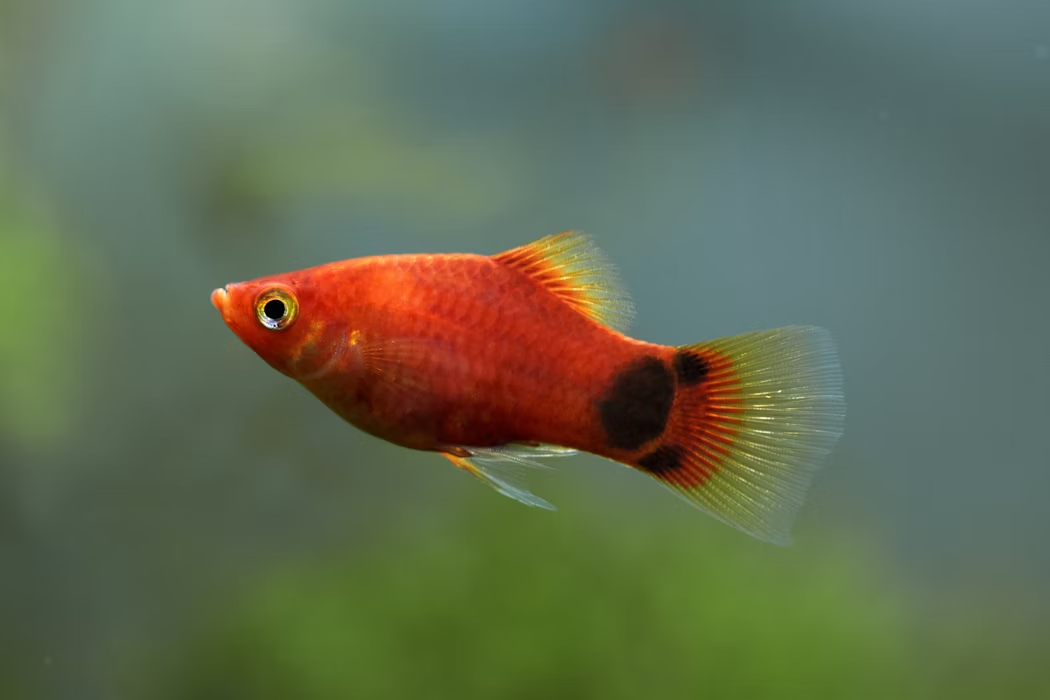Xiphophorus maculatus
var. Mickey Mouse Platy

科学分类
快速统计
水族箱建造信息
关于此物种
基本描述
详细描述
该物种原产于北美和中美洲流速缓慢的淡水溪流、运河和沼泽地带,已适应水流平缓、水草丰茂的环境。在家庭水族箱中复制这种自然栖息地是其长期健康的关键。一个种植有大量活体水草的水族箱有多种用途:它能模仿其原生环境,提供安全感,并为鱼苗提供庇护所,因为这种鱼繁殖能力极强。它们偏好中性至碱性、中等硬度的水质,这反映了其原生环境的矿物质含量。
作为高度社会化的群游动物,它们绝不应被单独饲养。群养能让它们感到安全,并展现出完整的自然行为。它们总是很活跃,栖息于从水底到水面的各个水层。这种活跃的天性加上中等的新陈代谢水平,需要每日喂食。作为真正的杂食性动物,其在野外的食物包括小型昆虫、甲壳类动物、蠕虫和植物。在圈养环境中,应以高质量的主食薄片或颗粒饲料来模拟,并辅以多样化的食物,如冷冻血虫、丰年虾和焯过的蔬菜,以确保营养全面。它们也会啃食生物膜和藻类,有助于保持水族箱的清洁。
从生理学上讲,它们相当强健。其耗氧量低、废物产生量适中,这使它们成为一个维护得当的系统中易于管理的成员。虽然它们是纯淡水鱼类,但对低盐度表现出轻微的耐受性,这一特性说明了它们对其沿海或邻近河口的原生栖息地的适应能力。由于其寿命相对较短,提供一个稳定、清洁和丰富的环境对于它们度过完整而活跃的一生至关重要。
科学描述
斑尾剑鳉(Xiphophorus maculatus)是花鳉科(Poeciliidae)的一种小型淡水硬骨鱼,该科以其卵胎生的繁殖策略而闻名。其原生分布范围遍及北美和中美洲,通常栖息于静水或缓流环境,如沟渠、运河和温泉。该物种表现出对硬质碱性水的偏好,这一特性与其富含石灰岩的原生地区的地质构成相符。
其形态学特征为纺锤形体型,这种体型在流体动力学上对其活跃的游泳行为非常高效。性二态性显著。雄性通常比雌性更小、更纤细,其特征是拥有一个被称为“交接器”(gonopodium)的特化臀鳍,用于体内受精。雌性体型较大,腹部更圆润,并拥有一个标准的扇形臀鳍。
在生态学上,斑尾剑鳉是一种机会主义的杂食性动物。其食物包括碎屑、藻类、小型甲壳动物和水生昆虫。作为生物膜的消费者,它在其生态系统的初级和次级营养级中扮演着角色。由于其分布广泛且种群稳定,其在《世界自然保护联盟红色名录》中的状态目前被定为“无危”(LC)。生理学上,该物种的特点是中等的新陈代谢率、低的耗氧量和中等的生物负荷系数。作为一种主要是淡水鱼的物种,它表现出显著的广盐性能力,有记录表明其能耐受低盐度的咸淡水环境。这种适应性促使其作为引进物种在世界多地取得成功。其繁殖方式为卵胎生(ovoviviparous),即雌性将受精卵保留在体内,直接产下可自由游动、发育完全的幼鱼。
繁殖描述
繁殖该物种被认为异常容易,它们常常在标准的混养水族箱中无需任何特殊干预即可繁殖。成功的关键始于一群健康、状态良好的成年鱼。为了保持适当的比例,能够区分性别至关重要。雄性可通过其特化的臀鳍来识别,该鳍呈尖锐的棒状,称为交接器(gonopodium)。雌性通常体型较大,身体更圆润,拥有传统的扇形臀鳍。为防止雌鱼因被雄鱼持续追逐而感到压力,建议保持至少每一只雄鱼配两到三只雌鱼的比例。
作为卵胎生鱼类,它们进行体内受精。经过约四周到六周的妊娠期后,雌鱼会产下活的、可自由游动的鱼苗。一胎可产下20到80条幼鱼不等。成鱼没有护幼行为,并会轻易地吞食自己的后代。为确保鱼苗的高成活率,可以采用两种主要方法。第一种是在主缸内提供大量的密集躲藏处,例如金鱼藻或爪哇莫斯等细叶水草丛,它们能提供天然的掩护。第二种更可控的方法,是在怀孕(gravid)的雌鱼临产前将其移至一个独立的专用繁殖缸。幼鱼出生后,应立即将雌鱼移回主缸。
新生的鱼苗从出生起就是独立的,必须喂食合适的食物。它们的饮食应包括微型食物,如草履虫、液体或粉末状的鱼苗饲料,以及新孵化的丰年虾。随着它们的成长,可以过渡到喂食精细碾碎的鱼用薄片饲料。全天少量多次的喂食对于它们的快速生长和发育至关重要。
相关图片

Mickey Mouse Platy
生成可打印卡片
为此生物创建可打印卡片,以便在您的商店或水族箱中展示。卡片包含二维码,可快速访问更多信息。





